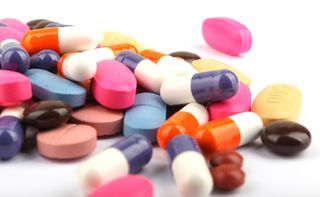Medication Mistakes Getting More Americans Sick

A rising number of Americans are getting sick from making medication mistakes at home — meaning they take either the wrong dose of medication, or the wrong drug, a new study finds. About 400 people died from such errors during the 13-year study.
The researchers analyzed information from a database of calls made to poison control centers across the United States. The scientists looked for cases in which people experienced medication errors that resulted in "serious medical outcomes," meaning the patients required treatment. The study included only cases in which the errors occurred outside of health care facilities, typically at patients' homes.
From 2000 to 2012, the poison control centers included in the study received more than 67,000 calls regarding these types of medication errors, the study found. Over this period, the number of yearly cases of serious medication errors increased, rising from 3,065 in 2000 to 6,855 in 2012.
The rate of these medication errors also doubled, from about 1 case per 100,000 Americans in 2000 to about 2 cases per 100,000 Americans in 2012. In about a third of the cases, people who experienced medication errors had to be admitted to the hospital.
The most common types of medication errors in the study included taking (or giving someone else) the wrong medication or an incorrect dose, or accidentally taking or giving medications twice in the same day when they were supposed to be taken only once daily. [How 8 Common Medications Interact with Alcohol]
The researchers called for making drug packaging and labeling clearer, along with enacting other changes, to help prevent these mistakes.
"Drug manufacturers and pharmacists have a role to play when it comes to reducing medication errors," Henry Spiller, a co-author of the study and director of the Central Ohio Poison Center at Nationwide Children's Hospital, said in a statement. "Dosing instructions could be made clearer, especially for patients and caregivers with limited literacy or numeracy," he said, referring to the ability to understand numbers.
Sign up for the Live Science daily newsletter now
Get the world’s most fascinating discoveries delivered straight to your inbox.
The most common symptoms in people who experienced serious medication errors included drowsiness or lethargy, low blood pressure, an abnormally fast or slow heart rate, and dizziness or vertigo, the study found.
Overall, about one-third of the patients were treated at a health care facility and immediately released, but 17 percent were admitted to a critical or intensive care unit (ICU) and 15 percent were admitted to a noncritical care unit.
The most common medications involved were cardiovascular drugs, such as beta blockers, calcium antagonists and clonidine; pain medications, including opioids and acetaminophen; and hormonal medications, including insulin. The researchers noted that during the study period, there was a general increase in prescriptions for cardiovascular drugs, insulin and opioids, which could have contributed to the rise in medication errors involving these drugs.
To prevent medication errors at home, the researchers recommended the following:
- Parents and caregivers should write down the time they give a medication to their child or loved one, which can help prevent another caregiver from giving the medication for a second time in the same day.
- Parents and patients should ask their doctors and pharmacists questions about their medications, until they fully understand how and when to take the medications.
- If you transfer medications from prescription bottles to weekly pill planners, make sure to use a child-resistant pill planner to prevent children from accidentally taking the medications.
The study was published online July 10 in the journal Clinical Toxicology.
Original article on Live Science.

Rachael is a Live Science contributor, and was a former channel editor and senior writer for Live Science between 2010 and 2022. She has a master's degree in journalism from New York University's Science, Health and Environmental Reporting Program. She also holds a B.S. in molecular biology and an M.S. in biology from the University of California, San Diego. Her work has appeared in Scienceline, The Washington Post and Scientific American.
Most Popular


